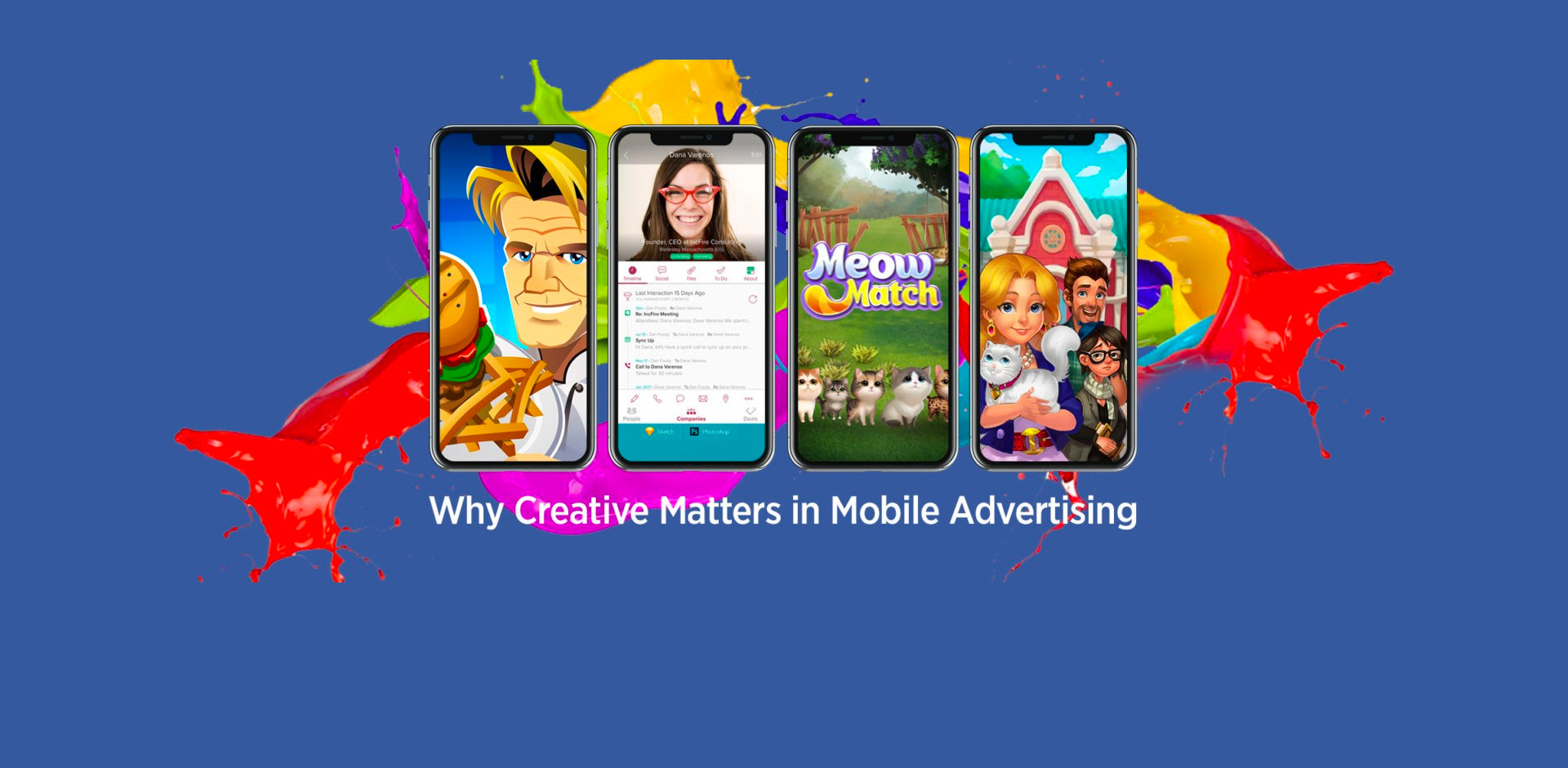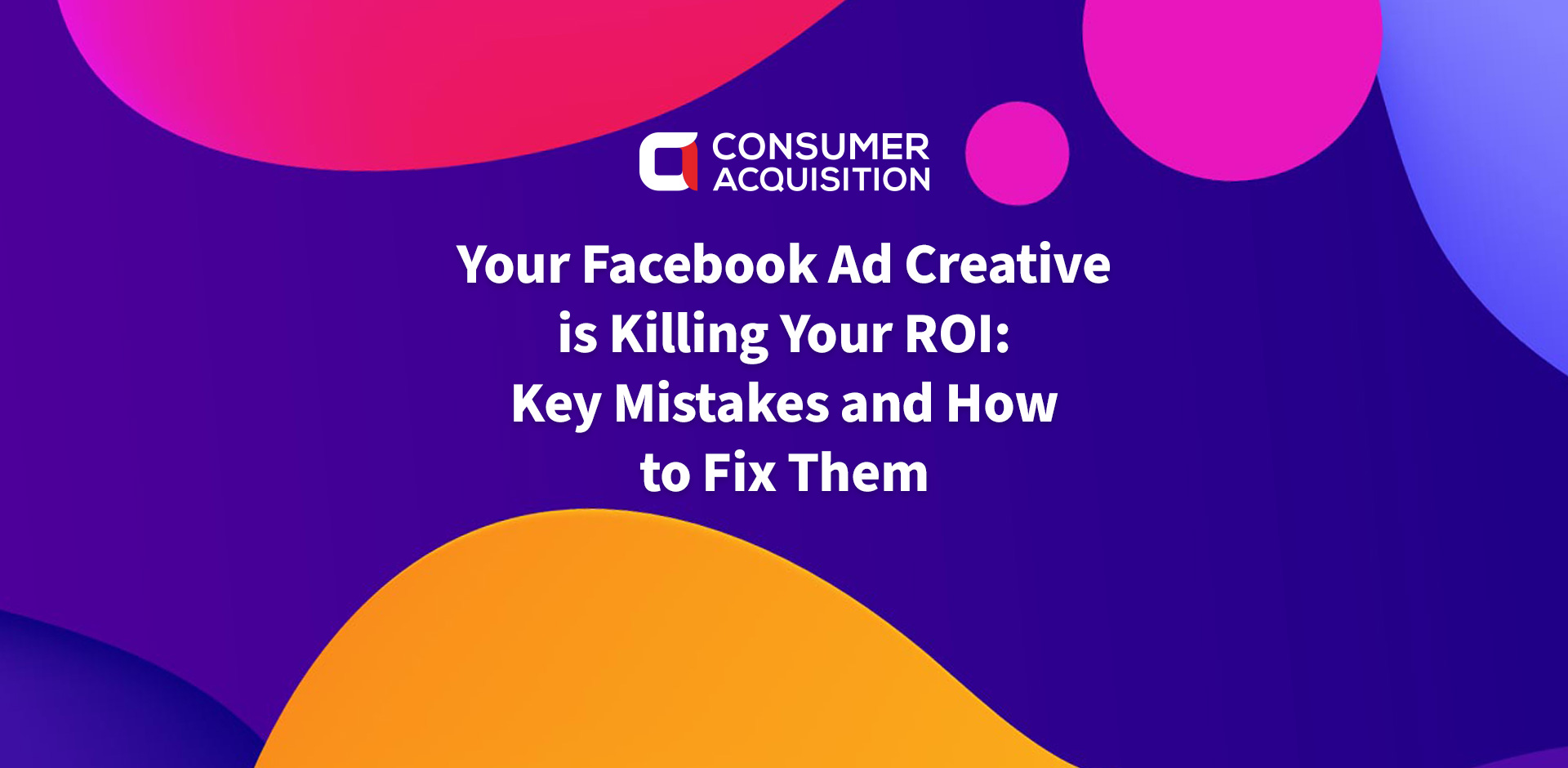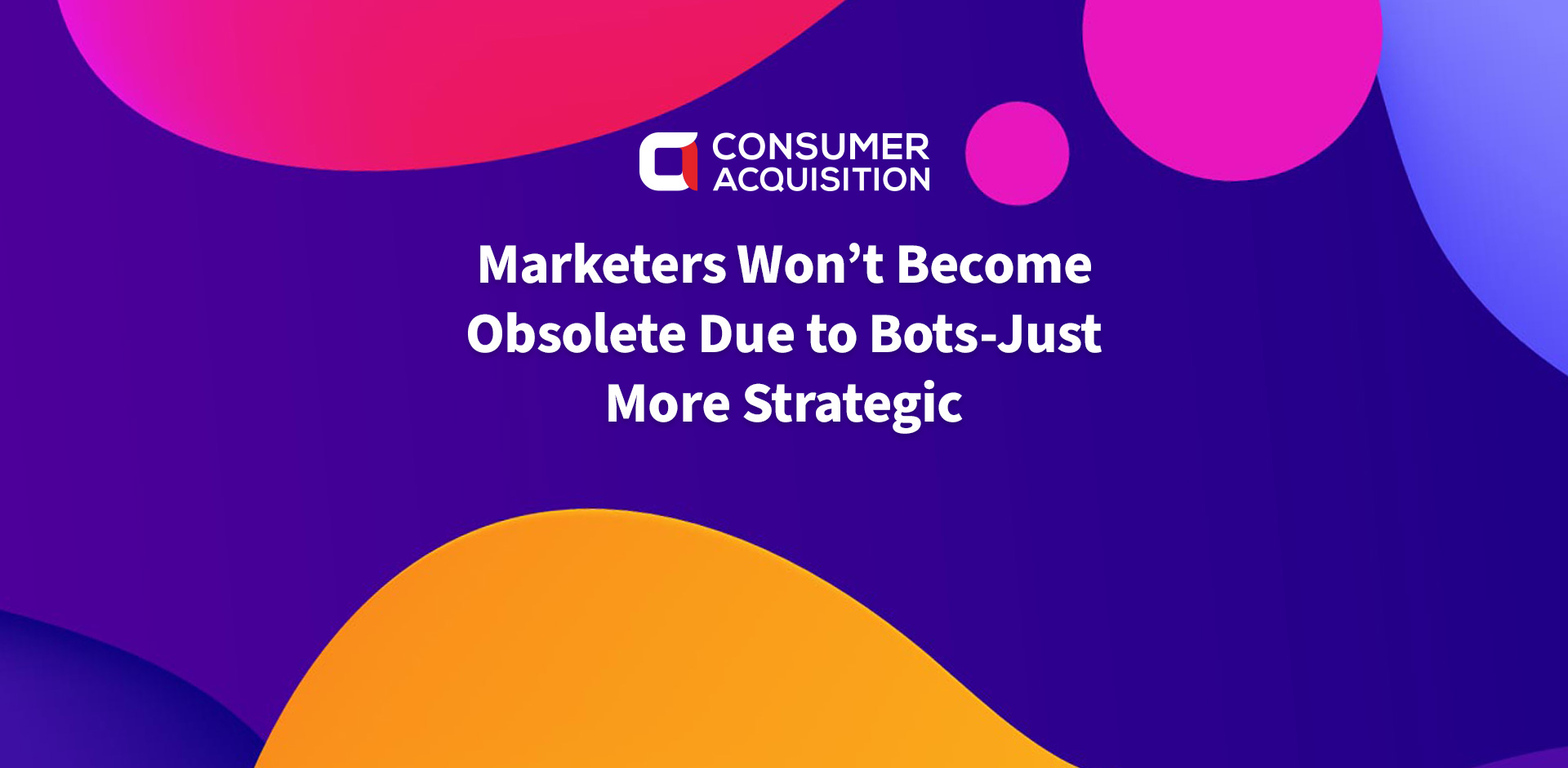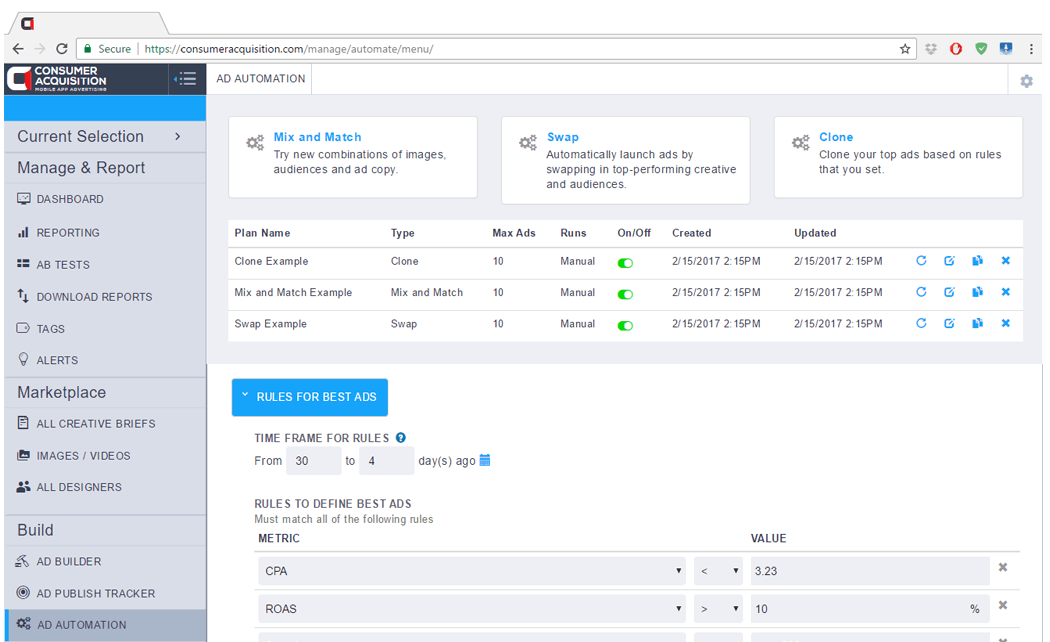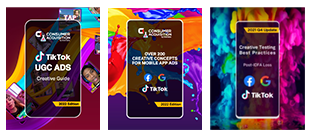Facebook Ad Creative
Learn how to identify and fix your key mistakes if your Facebook as creative is killing you ROI. Many advertisers have a “set it and forget it” approach to running user acquisition (UA) campaigns. Thus, using the same Facebook ad creative for endless months, with only minor adjustments to bidding and deprecating segments with the lowest click-thru rate (CTR). A formula for slowly killing click-thru rates, eventually this approach will result in an ever-declining return on advertising spend (ROAS).
In today’s highly competitive market, the “set and forget” approach isn’t sustainable beyond a couple of weeks. Viewers get fatigued seeing ad creative frequently and need to be visually attracted with new, fresh images and video constantly in order to capture consumer attention. To achieve and sustain the return on advertising spend (ROAS), advertisers can easily cycle through hundreds of creative monthly in order to find winners. And then continue to iterate with new variations to keep winners generating a positive response.
Generating and improving creative at scale can seem like a daunting task. But, the rise of creative marketplaces automates creative scale. As a result, advertisers can focus more on testing and iterate on key areas of their creativity to keep generating fresh imagery that converts:
You’re not preparing for creative testing. How to fix it:
As a Facebook advertiser, creative testing of new concepts is imperative (i.e. a high-performing video or image that you can scale while maintaining ROAS). However, creative testing can also produce significant financial waste, approximately 95% of creatives will fail at outperforming your current portfolio winner. To be more deliberate in your creative testing to surface winners, start by brainstorming ideas that will resonate with your audience and form a hypothesis around numerous creative variables. Forming a hypothesis before you start production, will guide creative iterations.
Before Testing
evelop a plan for testing 1 variable at a time and to avoid data contamination between tests. Ensure your test geo and demos are representative of your audience. Also, establish your key performance metrics (KPIs) upfront – is it impressions, conversion rate, install rate or volume, cart visits, checkouts, etc.
During Testing
If your test is running slow at delivering measurable results or your impressions are under-delivering, increase your bids by a specified percentage. Pause and re-run tests to ensure clean data.
Post-Testing
Consider lift in multiple key performance metrics to determine the winner. Test and iterate further through a continuous improvement approach.
Brand Guidelines
While developing a creative brief for designers to generate your ads, set your brand guidelines. Most large companies have a strong brand image accompanied by strict brand guidelines to represent companies in a consistent manner. Brand-driven organizations consider elements such as color palette, font treatment, logo placements, voice and tone to be used in copy, and more to develop brand-compliant creatives: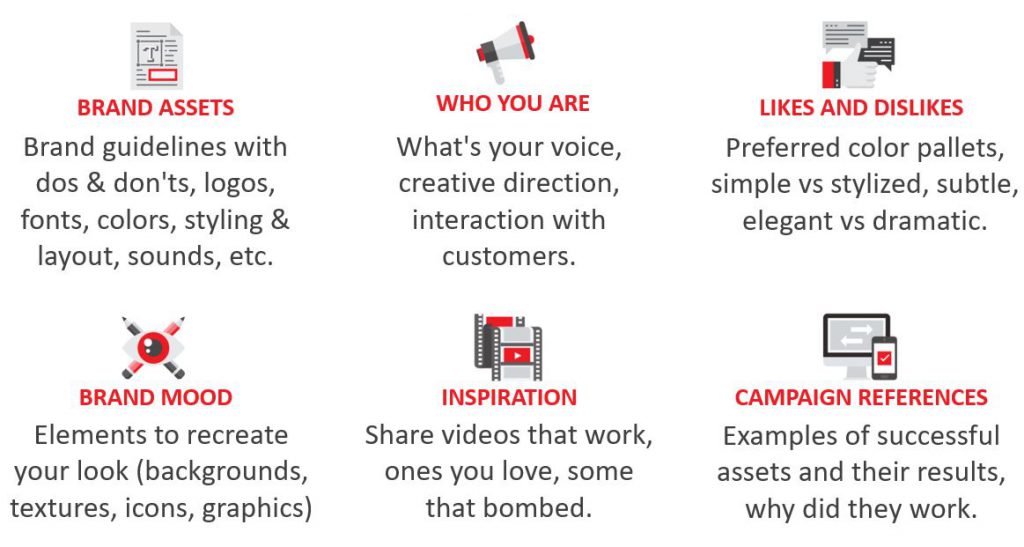
Brand Assets
Brand guidelines with dos & don’ts, logos, fonts, colors, styling & layout, sounds, etc
Who You Are
Brand guidelines with dos & don’ts, logos, fonts, colors, styling & layout, sounds, etc.
Likes and Dislikes
referred color pallets, simple vs stylized, subtle, elegant vs dramatic.
Brand Mode
Elements to recreate your look (backgrounds, textures, icons, graphics…).
Inspiration
Share videos that worked well, ones you love, some that bombed.
Campaign References
Examples of successful assets and their results, why did they work.
You’re not employing Facebook’s Best Practices for Videos. How to fix it:
A group of brand marketers, strategists, and creative directors at Facebook’s Creative Shop reviewed hundreds of top-performing ads, identified four different categories in which all of these ads fell into; basic in motion, brand in motion, benefit in motion, and demo in motion. These videos can be created with limited assets as they consist of still images and simple animations of different elements. Here’s an overview of each type of video ad:
Basics in Motion
A simple video or an animation. You can start with a still image and animate 1 – 2 elements of the image such as a character. You can also use music to add excitement.
Brand In Motion
A video with an emphasis on your brand. Start with a still, and add excitement by animating an aspect of your brand like your logo.
Benefit in Motion
A video with an emphasis on your products’ benefits. Start with a still, and add excitement by animating your product’s benefits with typography. Use short copy to make your video effective
Demo In Motion
A video with an emphasis on how your product works. For mobile games, you can screen capture gameplay and place it inside a phone. Not a mobile game? Show a demonstration of your product.
Basics, Brand, Benefit & Demo In Motion
A combination of your basics, brand, benefits, and demo in motion videos.
Additionally, here are some key tips and best practices on how to improve or fix videos to increase your ad’s user value:
- The first 3 seconds really matter, so open strong with a visually stunning image or graphic.
- Don’t rely on sound, but if it is important to deliver your message, be sure to emphasize it.
- Use a clear and concise copy. Text overlaid on a video ad can help support your message.
- Shorten the message. Viewers have a short attention span, so only make the message as long as it needs to be.
- Leverage your characters. If you have great characters that are recognizable to your brand, use them fully.
You’re not leveraging existing winning creative. How to fix it:
You can develop new winners from existing creative. Ad creative variations leverage pieces of winning images and ads and reposition existing elements to ultimately creative something similar, but new. Create variations of your existing creative by changing:
- Image Layout: A simple way to create new concepts is to showcase your product or service in several layouts like side-by-side, split-screen, grid (2×2, 3×3, 4×4), split-screen (½ & ½), split-screen variation ⅓ or ¼.
- User-Generated vs Stock Photos: The vast majority of pictures and videos you see on Facebook are user-generated, shared by family and friends. Professional photos or stock photography can look too perfect and tend to stick out on Facebook. Consider taking your own photos or degrading the quality of the images and videos to make them appear user-generated.
- Colors/Background: Test simple and plain backgrounds with soft or blurred out colors or gradients. Allow the viewer’s eyes to focus on bright vibrant foreground colors. Test soft background colors vs bold colors, strong texture vs muted texture, and simple vs clean vs busy and cluttered backgrounds.
You’re not writing powerful copy/calls to action. How to fix it:
Once you’ve grabbed the viewer’s attention with an eye-catching ad, it’s time to make the ask for the purchase or the download. Consider testing: different calls to action, language, copy and button color, copy placements, buttons, etc. You can also test variations of short vs long copy, as well as placements of the copy in the upper, middle, lower, left, and right corners of the ad.
You are not testing enough. How to fix it:
Constant creative testing – copy, video, images – becomes imperative to an organization’s objectives. A large volume of creative is needed not only to achieve and sustain ROAS because creative rapidly fatigues with increased spend and audience reach. Moreover, 95% of creative fail to outperform your portfolio’s best, so even when having a high-performing creative, you need to think about replacing it. See the graph below to understand the need and results of successful creative testing.
As the market is increasingly crowded, and automation tools continue to optimize how campaigns are run for efficiencies in delivering viewable impressions, targeting audiences, managing bidding, and budgets – ultimately, your creative becomes the differentiator for performance and financial success. Adopt and develop a testing plan that utilizes all the key variables to optimize your creative, and scale your acquisition program with your winning creative results.
![]() In May 2019, we were awarded a Google Premier Partner Badge; recognizing Consumer Acquisition as a leading social advertising and creative solution. Consumer Acquisition is Google’s only Partner in North America with a Creative and Premiere Certification. The Google Partner Program is a highly selective program designed to help customers identify the highest performing and most reliable companies based on their Google App Campaign social advertising and creative needs.
In May 2019, we were awarded a Google Premier Partner Badge; recognizing Consumer Acquisition as a leading social advertising and creative solution. Consumer Acquisition is Google’s only Partner in North America with a Creative and Premiere Certification. The Google Partner Program is a highly selective program designed to help customers identify the highest performing and most reliable companies based on their Google App Campaign social advertising and creative needs.![]() In addition to being a Google Premier Partner, we’re a Facebook Marketing Partner badged in Creative and AdTech. So, we’re uniquely positioned to help you with Facebook and Google App Campaign and creative and UA optimization. Contact us if you’d like to discuss how we can help with Creative or User Acquisition services.
In addition to being a Google Premier Partner, we’re a Facebook Marketing Partner badged in Creative and AdTech. So, we’re uniquely positioned to help you with Facebook and Google App Campaign and creative and UA optimization. Contact us if you’d like to discuss how we can help with Creative or User Acquisition services.


